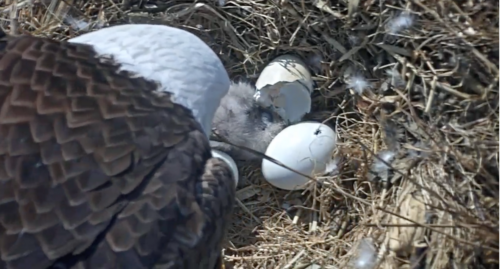
For the first time, three bald eagle eggs have been laid at the University of Notre Dame’s Linked Experimental Ecosystem Facility (ND-LEEF) in St. Patrick’s County Park. The first of the three bald eaglets hatched on Tuesday (April 2) and the last two eaglets are expected to hatch in the coming days. The pair of bald eagles, which claimed the former red-tailed hawk nest in 2015, laid three eggs at the end of February.
The community has been able to view the bald eagles and eggs via an in-nest eagle cam mounted in the tree above the nest. Installed in fall 2017 at ND-LEEF, the camera allowed viewers to watch the beginning of the nesting cycle, which included the bald eagle parents adding sticks and grass throughout January and February, followed by a 35-day incubation period once the eggs were laid.
“Over the next few months, eagle cam viewers can expect to see lots of interesting prey items being brought to the nest and the eaglets growing and learning to fly for the first time,” said Brett Peters, assistant director of ND-LEEF. “Although the eaglets are expected to depart at the end of summer, the community is encouraged to keep an eye out for upcoming ND-LEEF events and continue to watch the live feed to see how the bald eagle parents spend their fifth year at the facility.”
Before the eaglets leave the nest, ND-LEEF will host a “Breakfast with the Eagles” event on May 4 (Saturday) for the community at Morrison Family Pavilion in St. Patrick’s County Park. Attendees will have an opportunity to learn about the natural history of bald eagles, their recent comeback and how they became one of our national symbols. Following the presentation, spotting scopes and binoculars will be available to view the eagle nest and a light breakfast snack and beverages will be served.
Program content will be geared for participants age 10 and older, and a $7 registration is required by May 1 (Wednesday). To register, contact St. Patrick’s County Park by phone at 574-654-3155 or by email at bendixwoods@sjcparks.org.
ND-LEEF is a globally unique research facility, supported by the Notre Dame Environmental Change Initiative, that houses two engineered experimental watersheds, each consisting of an interconnected pond, stream and wetland. Scientists use ND-LEEF to conduct experiments in a field-like setting but in a more controlled environment than one can find in the wild. Both experimental watersheds are roughly the length and width of a football field and located 5 miles north of campus on 6 acres of land within St. Patrick’s County Park.
To watch the live, in-nest eagle cam or to learn more about ND-LEEF, visit environmentalchange.nd.edu/resources/nd-leef. Fans of the eagle cam are encouraged to share any exciting nest activity by using #NDEagleWatch and by tagging @NDLEEF on Twitter.
Contact: Brandi Klingerman, communications specialist, Notre Dame Research, bklinger@nd.edu, 574-631-8183; @UNDResearch
Originally published by at environmentalchange.nd.edu on April 2.